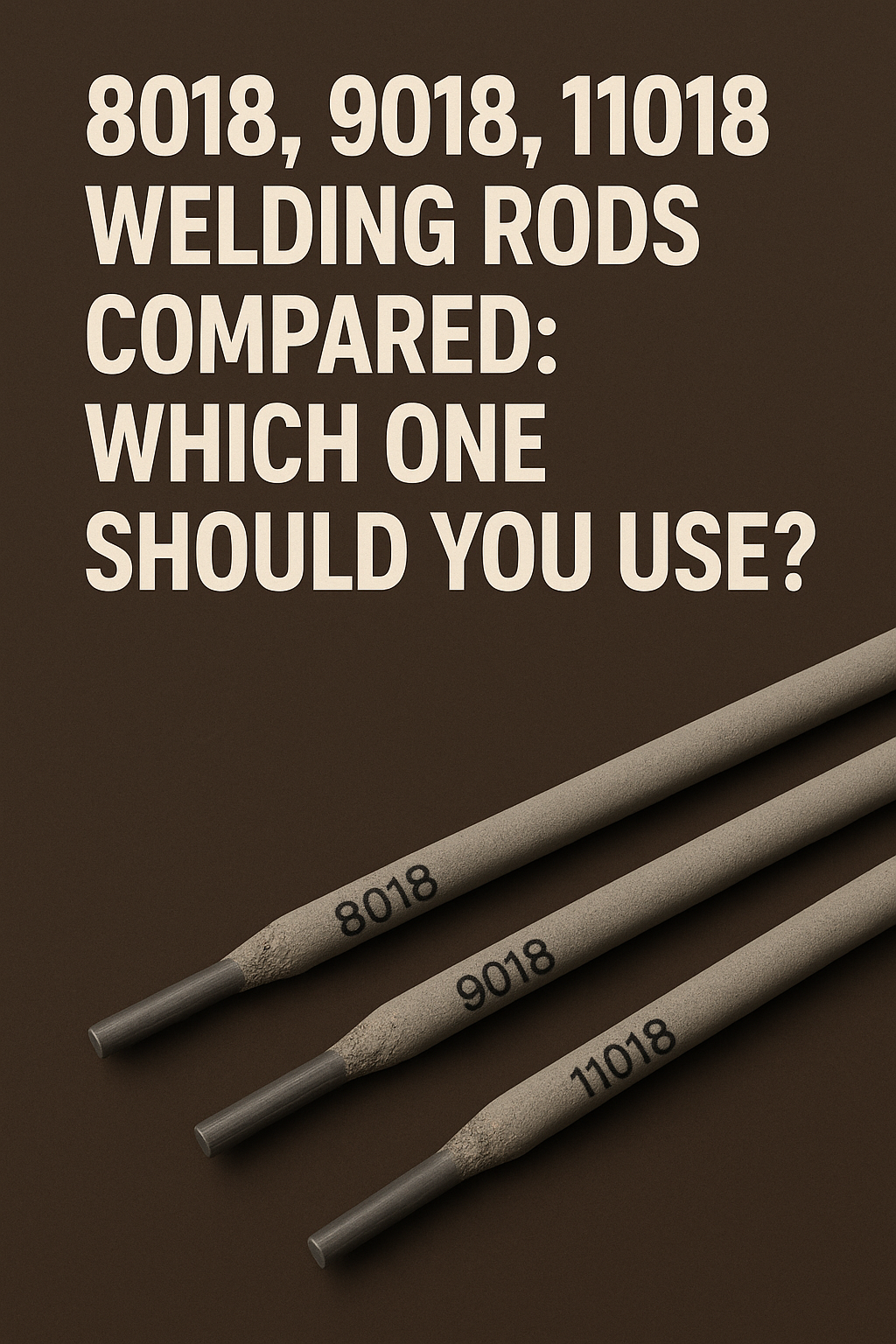“8018 vs 9018 vs 11018 Welding Rods: Strength, Versatility, and the Right Choice for Every Weld.”
Introduction
When selecting the right welding rod for a project, understanding the differences between 8018, 9018, and 11018 electrodes is crucial. Each of these low-hydrogen rods offers unique mechanical properties, tensile strengths, and recommended applications, making them suitable for specific welding tasks and industry standards. This comparison will break down the key characteristics, advantages, and ideal uses of 8018, 9018, and 11018 welding rods to help you determine which one best fits your welding requirements.
Performance Comparison Of 8018, 9018, And 11018 Welding Electrodes
When evaluating the performance of 8018, 9018, and 11018 welding electrodes, it is essential to consider several key factors, including tensile strength, ductility, usability, and the specific requirements of the welding project. Each of these low-hydrogen electrodes is designed to meet particular standards and applications, and understanding their differences can help welders make informed decisions about which rod to use for a given task.
To begin with, the 8018 electrode is widely recognized for its versatility and reliability in welding medium-strength carbon steels. It offers a minimum tensile strength of 80,000 psi, making it suitable for structural welding, fabrication, and repair work where moderate strength is required. The 8018 rod is also known for its excellent arc stability and ease of use, which allows for smooth weld beads and minimal spatter. Its low-hydrogen coating helps reduce the risk of hydrogen-induced cracking, a critical consideration when working with thicker materials or in environments where moisture control is challenging.
Transitioning to the 9018 electrode, one finds a step up in terms of tensile strength, as this rod is rated for a minimum of 90,000 psi. This increased strength makes the 9018 electrode a preferred choice for applications involving higher-strength steels, such as those used in heavy equipment, pressure vessels, and certain types of bridges. The 9018 rod maintains the low-hydrogen characteristics of the 8018, ensuring similar resistance to cracking and porosity. However, the higher alloy content in the 9018 electrode can result in slightly reduced ductility compared to the 8018, which may be a consideration in projects where flexibility and impact resistance are paramount. Nevertheless, the 9018 electrode provides a good balance between strength and weldability, making it a popular option for demanding structural applications.
Moving further up the scale, the 11018 electrode is engineered for the most demanding welding tasks, offering a minimum tensile strength of 110,000 psi. This rod is typically reserved for high-strength, low-alloy steels used in critical structures such as high-rise buildings, bridges, and pressure-containing components. The 11018 electrode’s robust mechanical properties ensure that welded joints can withstand significant stress and loading without failure. However, with increased strength comes a greater need for precise control over welding parameters and preheat or post-weld heat treatment, as the risk of cracking and reduced ductility becomes more pronounced. The 11018 rod is less forgiving than its lower-strength counterparts, requiring skilled operators and strict adherence to welding procedures to achieve optimal results.
In comparing the performance of these three electrodes, it becomes clear that the choice depends largely on the specific requirements of the project. For general fabrication and repair work where moderate strength is sufficient, the 8018 electrode offers an excellent combination of usability and performance. When higher strength is necessary, particularly in heavy construction or pressure applications, the 9018 rod provides a suitable upgrade without sacrificing too much ductility. For the most critical and high-stress applications, the 11018 electrode delivers unmatched strength, albeit with increased demands on technique and process control. Ultimately, selecting the appropriate welding rod involves balancing strength, ductility, and ease of use to ensure the integrity and longevity of the welded structure.
Choosing The Right Welding Rod: 8018 Vs 9018 Vs 11018
Selecting the appropriate welding rod is a critical decision that can significantly impact the quality, strength, and durability of a welded joint. When comparing the 8018, 9018, and 11018 welding rods, it is essential to understand the unique properties and intended applications of each to make an informed choice. Each of these rods is designed for specific types of steel and welding conditions, and their differences can influence the outcome of your project.
To begin with, the 8018 welding rod is a low-hydrogen, iron powder electrode commonly used for welding high-strength, low-alloy steels. It is known for its excellent arc stability, minimal spatter, and ease of slag removal. The “80” in its designation refers to its minimum tensile strength of 80,000 psi, making it suitable for structural welding where moderate strength is required. The 8018 rod is often chosen for its versatility and ability to produce sound welds in all positions, including vertical and overhead. Its low-hydrogen coating helps prevent hydrogen-induced cracking, which is particularly important when working with steels that are susceptible to this type of failure.
In contrast, the 9018 welding rod offers a higher tensile strength, rated at 90,000 psi, and is also a low-hydrogen electrode. This rod is typically used for welding higher-strength steels, such as those found in heavy equipment, pressure vessels, and critical structural components. The increased strength of the 9018 rod makes it a preferred choice when the welded joint must withstand greater loads or more demanding service conditions. Additionally, the 9018 rod maintains good weldability and produces a ductile, crack-resistant weld, which is essential for applications where safety and reliability are paramount.
Moving to the 11018 welding rod, this electrode is engineered for even higher strength applications, with a minimum tensile strength of 110,000 psi. Like the previous rods, it features a low-hydrogen coating, which is crucial for preventing hydrogen embrittlement in high-strength steels. The 11018 rod is often specified for welding quenched and tempered steels, such as those used in bridges, cranes, and other structures where maximum strength is required. However, it is important to note that as the strength of the electrode increases, so does the need for careful control of preheat, interpass temperature, and post-weld heat treatment to avoid issues such as cracking or loss of toughness.
When choosing between the 8018, 9018, and 11018 welding rods, several factors should be considered. The most important is the strength requirement of the base metal and the intended service conditions of the welded structure. For general structural work where moderate strength is sufficient, the 8018 rod is often adequate and offers ease of use. For applications demanding higher strength and toughness, the 9018 rod provides a good balance between weldability and performance. In cases where the highest strength is necessary, the 11018 rod is the appropriate choice, provided that proper welding procedures are followed to mitigate the risks associated with welding high-strength steels.
Ultimately, the selection of the right welding rod depends on a thorough understanding of the project requirements, the properties of the base metal, and the specific characteristics of each electrode. By carefully evaluating these factors, welders can ensure that they choose the most suitable rod for their application, resulting in strong, reliable, and long-lasting welds.
Key Differences Between 8018, 9018, And 11018 Welding Rods
When selecting the appropriate welding rod for a specific project, understanding the key differences between 8018, 9018, and 11018 electrodes is essential. Each of these rods is designed to meet particular requirements in terms of strength, composition, and application, making it crucial for welders to recognize their unique characteristics. By examining the composition, mechanical properties, and intended uses of these electrodes, one can make an informed decision about which rod best suits a given welding task.
To begin with, the numerical designation of each rod provides valuable information about its properties. The first two digits indicate the minimum tensile strength of the weld metal in thousands of pounds per square inch (psi). For instance, the 8018 rod offers a minimum tensile strength of 80,000 psi, the 9018 provides 90,000 psi, and the 11018 delivers an impressive 110,000 psi. This difference in tensile strength is a primary factor in determining which rod to use, as projects requiring higher strength will naturally benefit from the use of a rod with a higher numerical designation.
Moving beyond tensile strength, the third digit in each rod’s designation refers to the welding position for which the electrode is suitable. In the case of 8018, 9018, and 11018 rods, the “1” indicates that all are designed for use in all positions, offering versatility for a wide range of welding scenarios. The final two digits, “18,” reveal that these rods have a low-hydrogen, iron powder coating. This coating is significant because it reduces the risk of hydrogen-induced cracking, making these electrodes ideal for welding high-strength steels and critical structures where weld integrity is paramount.
Despite these similarities, there are notable differences in the chemical composition of each rod. The 8018 electrode is typically used for welding low-alloy, high-strength steels and is known for its good ductility and impact resistance, even at low temperatures. The 9018 rod, on the other hand, contains additional alloying elements such as nickel, which enhance its toughness and make it suitable for applications where higher impact resistance is required, such as in the construction of bridges or pressure vessels. The 11018 electrode stands out for its even higher alloy content, often including both nickel and molybdenum, which not only increases tensile strength but also improves resistance to atmospheric corrosion and extreme service conditions.
Another important distinction lies in the intended applications of these rods. The 8018 is commonly chosen for general structural welding, pipeline work, and situations where moderate strength and good toughness are needed. The 9018 is preferred for more demanding structural applications, particularly where higher strength and impact resistance are necessary. In contrast, the 11018 is reserved for the most critical applications, such as heavy equipment manufacturing, high-pressure piping, and structures subjected to severe stress or low temperatures.
In summary, while 8018, 9018, and 11018 welding rods share certain characteristics, their differences in tensile strength, chemical composition, and intended use set them apart. By carefully considering the specific requirements of a welding project, including the desired strength, toughness, and environmental conditions, welders can select the most appropriate electrode to ensure both the quality and durability of their work.
Conclusion
8018, 9018, and 11018 welding rods are all low-hydrogen electrodes designed for high-strength welds, but they differ in tensile strength and specific applications. 8018 rods are suitable for general structural welding with a tensile strength of 80,000 psi, making them ideal for most construction and repair work. 9018 rods offer higher tensile strength at 90,000 psi and are preferred for more demanding structural applications or where higher strength is required. 11018 rods provide the highest tensile strength at 110,000 psi and are used in critical, high-stress environments such as heavy equipment, bridges, and pressure vessels. The choice depends on the required strength, code specifications, and the application’s demands: use 8018 for standard structural work, 9018 for higher-strength needs, and 11018 for the most demanding, high-strength applications.


Leave a Reply